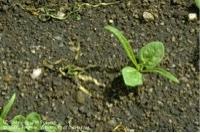Damping off
-
AboutSeedlings sometimes fail to sprout or die soon after. Seeds may rot before germinating, shoots may decay before they emerge, or stems of seedlings may be attacked near the soil line, causing young plants to collapse. These diseases are collectively called “damping off,” likely caused by a number of soil-inhabiting pathogens.
 Photo: Courtesy UC Regents
Photo: Courtesy UC Regents -
Category
-
Fungi
-
-
Signs/Symptoms
Seeds rot before they germinate.
Shoots decay before they emerge.
Stems of seedlings rot at the soil line.
-
Where
Seeds, shoots, seedlings.
-
When
When starting seeds or planting seedlings.
Damping off is most common when soil is compacted and conditions are wet and cool.
-
Prevent
To manage damping off, plant at the right time, germinate seeds indoors in disease-free soils, and follow planting practices that reduce disease risk.
Plant when temperatures are favorable for rapid seedling growth:
Don't plant seeds or transplants into cold, wet soil.
If you want to start plants earlier, plant seeds indoors and transplant later.
If planting potato seed pieces, be sure soil is at least 50°F.
Reduce waterlogging in planting beds by improving drainage:
Use raised beds.
Add organic soil amendments.
Avoid using unfinished or green compost, which holds water and promotes disease development.
Use good cultural practices for seedling plants:
Don't over water.
Thin plants after they emerge to improve air circulation.
Don't over fertilize with nitrogen.
Rotate crops to avoid planting the same crops in the same place year after year.
Employ good sanitation practices:
Use clean pots.
Remove and discard diseased plants.
For plants grown in pots or cold frames, use steam-treated soil or pasteurized potting mix.
Use the highest quality seed available.
-
Manage
See above. To manage damping-off, plant at the right time, germinate seeds indoors in disease-free soils, and follow planting practices that reduce disease risk.
-
More Information

